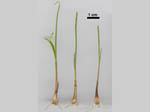A European Project with Seven Partners
General Information
EURALLIVEG is a project granted by the European Commission,
Directorate-General for Agriculture and Rural Development, under
the Council Regulation No 870/2004 under the project number AGRI GEN RES 050.
Its active period was from April 1, 2007, until March 31, 2011. Its main results, however,
are persisting further long time beyond this period.
AGRI GEN RES is the abbreviation of the programme ‘Genetic resources in agriculture’.
This programme promotes genetic diversity and the exchange of information including
close co-ordination between Member States and between the Member States and the
European Commission for the conservation and sustainable use of genetic resources in
agriculture. It facilitates also co-ordination in the field of international
undertakings on genetic resources. The total budget allocated to this programme
amounts to 10 million Euro. Please read further details on the website of the
GENRES programme.
In the frame of this programme, it was a targeted action whose total costs amounted
to 1.089.000 Euro including co-funding by EU of 544.500 Euro.
Plant germplasm which has to be propagated and maintained vegetatively is the
most expensive part of all the material held in genebanks. Therefore, projects
to rationalize this part of the genetic resources have high impact on costs
and labour requirement for the management of living plant collections. Garlic and
shallot are such crops held in Europe in several genebanks. They are the target
species of this project. A recent survey about vegetatively propagated alliums
in Europe, given in the IPGRI Newsletter for Europe 32: 7 (2006), is downloadable from
the homepage of Bioversity International.
To use efficient alternatives to the laborious field cultivation, which is
at risk by many biotic (pests and diseases) and abiotic (flood, drought,
cold winters) factors, new ways of modern biotechnology were used in this
project. Cryopreservation formed the core activity of the project. It
was organized in a Cryobanks Network, initially formed by three partners,
the Czech, Polish and German genebanks. It is open for joining of other
institutions. To get right material in this base collection, it meets
the criteria of a Most Appropriate Accession (MAA) and is unique. Molecular
markers help to eliminate duplicates. They were used as actions for garlic and
shallot. Plant health is another important factor, which will can be improved by
meristem culture for virus elimination. This was done for in garlic. The virus eliminating
effect of cryopreservation will be further explored. The project was highly integrative
and needed close collaboration of the partners.
Europe has a long tradition of garlic utilization. Because of the cultural
and climatic diversity of this continent, various forms of use and, hence,
selection in different directions, garlic diversity is very high in Europe.
This is represented by a whole set of garlic collections in Europe. Europe’s
garlic germplasm maintenance is, like that of all the other crops, supervised
and coordinated by the European Cooperative Programme for Crop Genetic
Resources ECPGR,
which is structured into working groups within thematic networks. The
Allium Working Group
is one of them. A crop-specific database is coordinated by this group,
the European Allium Database
EADB.
Here all, who are interested in passport and other data about
garlic and other alliums, can get information.
Images are not only nice to look at. They also important tools to identify plant accessions
in a germplasm collection. As one of the activities to present garlic and shallot accessions IPK has
endeavoured to establish an image database covering its Garlic and Shallot Core Collection. This database
contains not only pictures but also passport and characterization data as well as infraspecific
grouping which was performed by means of morphological characters, isozyme and RAPD markers
for a considerable part of the garlic collection in 1995 by Helga Maaß and Manfred Klaas
(citation in the image database).
The main results of the project consist in
establishment of a cryopreserved garlic genebank covering 202 core accessions of the Czech, German,
Polish, and Italian genebanks; these accessions are safety-duplicated in a black-box regime
according to the international rules of genebanking. The safety-duplicated collection is fixed
in a Consignment Agreement;
another set of candidate accessions from Czech Republic, Germany, Poland, Italy, and France
are fully or incompletey cryopreserved; safety duplicates need to be exchanged in near future;
the Core Collection is described by passport and morphological data as well as
by images in the EURALLIVEG Catalogue;
a survey on the infra-structures of the garlic and the shallot genepool represented by the EURALLIVEG accessions;
virus-free garlic accessions, partly already in cryopreservation.
For details about partners see the Organisation page.
|









